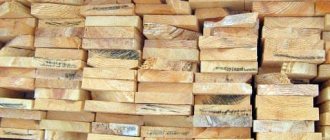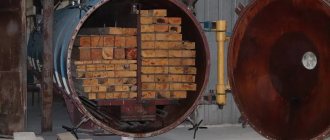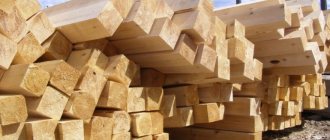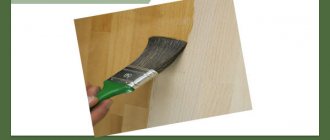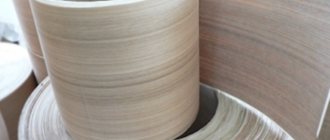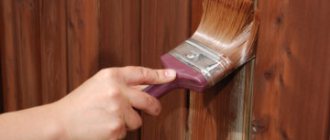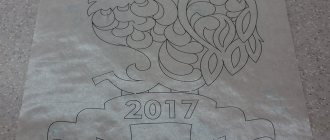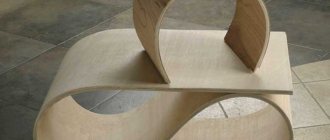A little about the properties of wood
The humidity of a growing tree depends on the time of year: in early spring the humidity is highest, but in winter, on the contrary, it is minimal.
If you harvest wood when it has a low moisture content, it will be more resistant and will crack less when dried. The more the material dries, the larger and deeper the cracks in it. “Soft” wood dries out less, but faster than hard wood. There are three groups of rocks (according to the degree of shrinkage):
- Severely drying: birch, apple, larch, maple;
- Medium: aspen, elm, oak, ash, linden;
- Small degree (often coniferous): cedar, spruce, pine, poplar, willow.
It is ideal to harvest any species, except aspen, in late autumn or early winter, then the amount of juice is the lowest and all you have to do is dry it on your site.
Need for drying
Wood blanks in the form of logs have a high degree of moisture, so they will need to go through a cycle called wood drying. The moisture contained in the workpieces can gradually decrease naturally, but this will take a long time and will lead to a chaotic phenomenon of compression and expansion within the wood fibers. For this reason, drying of workpieces is carried out under strict control and under certain conditions.
Damp and undried wood structure has a tendency to rot, crack and bend. To avoid such unfavorable phenomena, various methods are used to bring wood to condition, with specified humidity level parameters. Drying conditions and cycle duration directly depend on the method of removing excess moisture.
Each wood drying method has its own properties, having both advantages and disadvantages.
Wood drying methods
There are many ways to dry wood. Their task is the same - to obtain reliable wood, the properties of which will be significantly improved. On average, the drying time for lumber under natural conditions ranges from a week to several months, and under artificial conditions from a couple of hours to several days.
Old ways
The oldest method of drying is evaporation. They have been used since ancient times. The wood was placed in a container with water at a temperature of 70 degrees, sawdust was poured on top, and so the material was steamed. As a result, the material did not crack and became dense and flexible.
Another long-standing method is waxing. The wood was dipped into liquid paraffin and left for several hours. After this treatment, the wood did not warp and became a rich dark shade. Paraffinization was more often used for wood to make tableware. Such products lend themselves well to painting and accept varnish. They also became stronger, and cracks never formed on them.
Natural drying
Quality wood is not easy to obtain in a short time frame. Natural drying is often the solution. If the tree is a block of bark, then it should not be removed by making cuts across the trunk.
Even when sanded, wood such as birch, alder, aspen and linden dries without cracks, so for safety it is better to cover the ends with resin or oil.
Natural drying is carried out in a ventilated and dry room. If you do this under the sun, only the outer layers will heat up, while the inside will remain wet, provoking the appearance of multiple defects later.
The workpieces are laid out on stands no less than 60 cm in height, with gaps left between them.
The natural drying period is 2 – 3 years. Such a long time is one of the disadvantages. The advantages include the simplicity of the process and the absence of the need for large financial investments.
Chamber drying
If the goal is an excellent result and there are means to achieve it, you can pay attention to chamber drying. It is characterized by highly effective results, allows you to monitor the process and obtain wood at the required moisture content. It is carried out only in specialized enterprises under the influence of a gaseous environment. Moisture evaporates. Modes may change.
Drying in a special chamber
Drying chambers are special metal devices equipped with aerodynamic heating. When drying, low pressure steam enters them. The cost of the process is high due to energy costs.
Rotary drying
It is based on the use of centrifugal force. Lumber is stacked on a platform located inside a well-heated room. Centrifugal force forces moisture to move to the ends and outer surface of the workpieces.
The active movement of hot air helps to dry the wood evenly in the shortest possible time. To obtain heat, special lamps and stoves are used. Infrared radiation spreads quickly and penetrates 12 mm into the wood. As a result, conifers up to 25 mm thick can be dried in a few minutes - this is several times faster than chamber drying.
Contact drying
In another way, such drying is called conductive. It is carried out using heat transfer from a heated surface. The method is well suited for thin materials - veneer or plywood. The sheets are fixed with a press between heated plates.
Atmospheric drying
The most common method of drying due to minimal cost is atmospheric. Its implementation does not require the use of additional resources; it can also be easily organized independently.
The productivity of the process depends on the environmental humidity in the area, the season and air temperature. Also, drying will require quite a lot of space and compliance with the following rules:
- arrangement of a shed or shed with through ventilation;
- laying boards in rows at intervals;
- laying weights on top to prevent warping.
If air humidity is low, then you can get material with 12 - 48% humidity. It is allowed to finish drying the lumber in a heavily heated room.
Drying in liquid
Used as an additional measure before applying impregnation with oil-based antiseptics. Solutions of mineral salts, paraffin, sulfur, and molten metal are used as liquids.
Drying in special liquids
The drying time depends on the intensity of heat redistribution and the power of the heat exchanger in the drying chamber. The tree is immersed in liquid, which is brought to a boil. A constant temperature is maintained until free moisture is completely removed. The approximate duration of the process is from 3 to 20 hours.
Proper drying of boards is a complex process.
Wood has the properties of absorbing moisture like a sponge. When exposed to humid air, wooden boards absorb tiny drops from the environment, swelling and becoming larger. Dry air makes wood drier and smaller. It is important that the tree receives an equilibrium moisture content with the surrounding air.
It would be ideal if the boards were dried evenly to the humidity level at which they are planned to be used. This rule is important for drying wood in any conditions, be it a special drying chamber, a garage or an open area on the street.
Craftsmen note that due to the reduction in the mass of wood after drying, it is much easier to work with it than with wet wood.
This process has its own difficulties:
- each type of wood requires a separate approach; drying birch and fir, for example, is different;
- if something goes wrong: the process of rotting has begun or the wood has cracked, then the boards will have to be thrown away or energy spent on masking the damaged areas;
- It is necessary to dry it in a thoroughly ventilated area; sometimes it is necessary to build fans and homemade electric dryers.
General tasks and drying conditions
The need for this process arises in relation to fresh or damp wood. Too high a moisture coefficient in the structure of the material will not allow solving most construction and repair problems. Usually we are talking about how to properly dry boards, which can be used in finishing vertical and horizontal surfaces.
In principle, the process of drying wood is natural. When the structure of wood fibers has access to the air, humidity regulation to optimal values from the point of view of construction tasks occurs by itself. The only problem is the time that this operation may require without the use of special means.
The type of wood will also matter. For example, how to dry birch boards correctly? This is a typical representative of lumber that is undemanding to drying conditions, like poplar, which does not crack and does not require removal of the bark before the procedure. The opposite of birch in this regard is oak, which needs to be completely stripped before drying. Moreover, oak boards may require several years to dry completely.
Drying wood at home: do-it-yourself impeccable quality
If you use your own materials, then before starting construction work it is important to properly dry the wood.
Bitumen shingles here tegola.ua/bitumna-cherepitsya/ the best choice, excellent Italian quality, professional approach! Look at examples of work, very impressive!
Undried boards are a terrible headache later. They not only quickly turn black and rot, but are also easily deformed, making them almost impossible to work with. By carrying out proper drying, you will get rid of most problems later.
Drying levels
Different purposes require their own degree of drying, the value of which will be expressed in the moisture coefficient of the structure. Technologists distinguish several types of wood structure depending on this indicator:
- From 2 to 8% is the lowest level of humidity, thanks to which lumber can be used in the manufacture of furniture.
- From 2 to 15% – wood for rough finishing of surfaces. This material is used to lay coverings for terraces and paths, as well as for flooring.
- From 8 to 15% - products suitable for a carpentry workshop. They can be solid or glued, but they are optimal for structural elements. Some types of lumber can be prepared for such work at home. For example, how to dry boards outside to achieve such a percentage of moisture? Additional chemical treatment is required, the effect of which will be supported by favorable climatic conditions and the properties of the rock itself.
- From 18 to 22% - undemanding wood from the point of view of processing technologies, which is widely used in households and industry. From lumber with this level of humidity you can build houses, make containers, etc.
Evaporation methods
One of the oldest drying methods, which can be used in our time, maintaining the proper level of technical properties of the material. It’s worth returning to the main question: how to dry the boards so that they don’t leak? The answer to this requires a more expanded view of moisture removal technologies. Not only its content in the structure can cause negative processes of board deformation. It is much more difficult to remove the natural juices of wood, which also complicate mechanical processing at the stages of preparing the product for installation.
The evaporation procedure at 60-70 °C will help solve these problems. You need to take the same vat or another metal container, fill it with sawdust and fill it with water. Next, a board is immersed there, after which the container is placed on low heat to simmer. This process ultimately not only helps remove deep moisture from the structure, but also physically strengthens the material.
Wood drying technology
Wood drying technology includes the use of modern equipment using special knowledge and personal experience. Since raw materials in their raw form do not have the strength that is expected of them, they must be handled carefully. If not dried properly, the wood may burst or separate along the fibers. All this will lead to unusability of the lumber.
The drying process consists of alternately using high and low temperatures. The first stage involves intensive heating of the material. When the liquid evaporation temperature is reached, the material loses moisture from the upper fibers. At the same time, its mass also decreases by approximately 40-50%. Various heat sources can be used for heating. Often, their operation is regulated by several sensors, so that the entire process runs smoothly and safely. Only in this case is it possible to quickly dry the wood.
High-temperature drying of wood promotes rapid evaporation of moisture from the upper layers of wood. There are other types of drying, but they all involve some investment in one way or another. However, quite a lot of liquid remains in the middle of the product, which also needs to be evaporated. If you continue to heat the wood, excess pressure forms inside. Since the outer layers are already dry, steam from the inner fibers tends to escape. The outer fibers are less elastic, so they will not withstand the internal pressure and will burst. To avoid this, use the steaming method.
The raw material is exposed to superheated steam, due to which the upper layers of the wood soften and become more elastic. This allows the accumulated steam inside to escape without tearing the wood. The steam exposure is also controlled by sensors to achieve complete drying.
After the material has dried completely, it must be moistened to a certain ratio. This procedure is necessary for the product to gain some elasticity and firmness. Completely dry material is extremely brittle and should not be used during construction. Humidification allows you to adjust the moisture content of the internal and external fibers of the lumber. To achieve maximum effect, these operations are repeated several times, starting with heating. Thanks to this, the finished product has both strength and flexibility. It is important to correctly establish the cyclicity of processes and observe all wood drying modes.
Drying freshly purchased lumber
Forced drying of wood.
Often, summer residents who have bought fresh, rather expensive lumber, handle it very recklessly. Therefore, it seems that the boards were purchased only to turn them into rotten places. Fresh boards turn black very quickly if they are not dried according to all the rules. The main thing is that no special knowledge or tools are required here. All you need is fresh air and a little attention. Thanks to natural drying, excellent dry lumber can be obtained. At the same time, you should be prepared for the fact that sometimes you have to wait a year or even more. To get dry boards on time, construction should be planned in advance, since any work with dry boards is a pleasure for a professional, and even beginners can handle it quite easily.
Raw material always causes a lot of problems, and subsequently you have to redo a significant part of the work. It is important to correctly choose the place where you will store the boards; the quality of drying largely depends on this. What are the most favorable places for drying boards in your summer cottage? Of course, all those that are protected by a canopy are better, since in this case there is no need to install additional shelter. Also, don't make the stack too wide, no more than 1 meter. Any height is allowed.
Wood drying methods
There are several basic methods for drying the building material in question. The most optimal one is determined by the type and species of wood, as well as other factors that affect the work process.
Microwave drying of wood is based on the operating principle of ultra-high frequency pulses. Thanks to a controlled electromagnetic field, the moisture inside the fibers quickly heats up and comes out in the form of steam. Superheated steam can also be used to level a product that is damaged by dampness. Excess steam is removed from the chamber using fans.
Another method of drying wood that is suitable for small batches of material is drying wood in the microwave. This option will be optimal for preparing a thin bar or strip for a small product. Since a large cut will not fit in the microwave, it is best to use the quick drying method.
Rapid drying of wood allows you to obtain almost dry raw materials in a relatively short time. The essence of the method is to use an oven or a powerful heater. If you dry wood in the oven, you need to set the temperature above average and place the product as high as possible from the heat source. Using this method, you should be extremely careful to prevent spontaneous combustion of the wood.
If you use a powerful heater for drying, then the wood needs to be wrapped in several layers of paper or newspaper. After that, cling film or plain film is applied over the paper. You need to make holes in it to allow moisture to escape. After preparing the wood, the product can be placed on the heater. The paper should be changed every 7-8 hours.
Wood treatment with infrared rays
This method allows you to get an almost dry product in a short time that you can work with. However, the cost of equipment and covering expenses during its use significantly increase the cost of finished products processed in this way. The infrared wood dryer has large dimensions, so its installation requires a large area. Infrared drying acts on the moisture inside the wood, causing it to heat up and escape through microcracks in the wood. The rotational method of drying wood allows you to reduce the number of microcracks in the wood and reduces the internal stress in the material. Due to this, a balance is achieved between moisture evaporation and maintaining the necessary elasticity.
Vacuum drying of wood
Processing wood using this method is a very expensive production. Since setting up a drying shop requires not only premises, but also expensive equipment, drying simple wood is too expensive. Therefore, only noble species such as oak, ash, cedar or beech are subjected to this treatment. The quality of the dried product is much higher than that of its predecessors, but high energy costs narrow the scope of application of this method. Some private entrepreneurs assemble such installations themselves, but vacuum drying of wood with your own hands will require large investments.
This type of wood drying takes quite a lot of time and the result may not live up to expectations. The essence of the method is to store lumber in an open area, but under a canopy. As a result of natural airflow, moisture slowly evaporates from the wood. Warm air currents remove residual evaporation and excess moisture from the outer fibers of the wood. In this way, a natural balance of moisture in the material is achieved.
In order to obtain the most even and high-quality lumber at the end, it is necessary to put in a lot of work to securely fix the wood and prevent it from twisting. Although this option is more economical than all others, it requires more time and costs to organize the process.
This type of wood drying takes quite a lot of time and the result may not live up to expectations. The essence of the method is to store lumber in an open area, but under a canopy. As a result of natural airflow, moisture slowly evaporates from the wood. Warm air currents remove residual evaporation and excess moisture from the outer fibers of the wood. In this way, a natural balance of moisture in the material is achieved.
In order to obtain the most even and high-quality lumber at the end, it is necessary to put in a lot of work to securely fix the wood and prevent it from twisting. Although this option is more economical than all others, it requires more time and costs to organize the process.
This type of wood drying takes quite a lot of time and the result may not live up to expectations. The essence of the method is to store lumber in an open area, but under a canopy. As a result of natural airflow, moisture slowly evaporates from the wood. Warm air currents remove residual evaporation and excess moisture from the outer fibers of the wood. In this way, a natural balance of moisture in the material is achieved.
In order to obtain the most even and high-quality lumber at the end, it is necessary to put in a lot of work to securely fix the wood and prevent it from twisting. Although this option is more economical than all others, it requires more time and costs to organize the process.
Atmospheric drying of lumber
This type of wood drying takes quite a lot of time and the result may not live up to expectations. The essence of the method is to store lumber in an open area, but under a canopy. As a result of natural airflow, moisture slowly evaporates from the wood. Warm air currents remove residual evaporation and excess moisture from the outer fibers of the wood. In this way, a natural balance of moisture in the material is achieved.
In order to obtain the most even and high-quality lumber at the end, it is necessary to put in a lot of work to securely fix the wood and prevent it from twisting. Although this option is more economical than all others, it requires more time and costs to organize the process.
Conductive method
Using this method allows you to get the highest quality wood with the right amount of moisture in it. Its essence lies in the use of hot plates and pressing wood between them. This way it is possible to dry the wood without damaging the outer fibers. The press applies a force that is set individually, depending on the type and thickness of the wood.
Chamber drying of wood
Chamber drying of lumber is one of the highest quality and fastest types of lumber processing. In drying chambers, it is possible to maintain and regulate many basic factors, such as air temperature, humidity or speed of movement in the chamber. Thanks to this, you can get a really high-quality wood product - dried timber or board.
The liquid drying process involves liquids that do not react with water. These can be various oils, fats, paraffins and other compounds that do not dissolve in water and do not dilute it. To dry wood in such liquids, it is necessary to create and maintain a temperature of more than 100 degrees. The immersed wood also heats up and moisture evaporates from it. Because the temperature of the oil is higher than the boiling point of water, moisture escapes through the expanded fibers of the wood. The different densities of liquids facilitate the evaporation process and the liquid comes to the surface of the oil.
Home drying of wood
In addition to industrial methods of drying wood, there are also home ones.
Using a microwave
The advantages of this method are that when it is used, tiny cracks do not form in solid wood, which can turn up to one and a half centimeters of material from each end into waste, and in some cases even break the workpiece into pieces. Under the influence of microwave heating, changes occur in the lignin fibers, due to which an object dried in this way loses its sensitivity to sudden changes in humidity.
For the drying procedure, a not too powerful, budget microwave model without unnecessary options is suitable. The main thing is that it has a low power mode. It usually corresponds to o, or "defrosting". The chamber must be large enough to accommodate crafts or wooden pieces. Often the chamber is larger in width than in depth.
How to dry boards quickly
There are times when you need to quickly dry small boards at home, which is especially important in winter. There is one simple, time-tested method for this.
The essence of the method is as follows. A board from a recently cut tree is wrapped in paper (5...15 layers), then the material is wrapped in plastic film and several holes are made to allow moisture to escape.
The pre-prepared board is placed on a heated radiator or other place located in close proximity to the heating device. As the wood dries, some of the moisture will be absorbed by the paper, so the wrapping material needs to be changed 3-4 times a day. While drying, the board needs to be turned over several times a day.
The drying time of lumber depends on its thickness. So, three days are enough to dry a 3-centimeter board.
Products of greater thickness take longer to dry, but much faster than with natural drying.
The method under consideration has one significant drawback - deformation of the wood surface. This disadvantage can be easily corrected by processing the board with a plane.
Features of the choice of materials
Fresh wood can be compared to a sponge that is saturated with moisture. Natural moisture in wood can be external or internal. The purpose of drying wood is to completely get rid of internal moisture.
Drying wood at home is a long and complex process, but necessary. Damp boards quickly turn black and rot, their surface becomes fleecy and difficult to process. Once in a drier environment, the wood begins to dry out unevenly. This is the reason why the boards crack and deform, gradually losing volume, which is why the structures shrink.
Dry wood is much easier to process, it is much stronger and more reliable. Proper drying is the key to high quality wood materials and, as a result, the strength of finished products. Also, the quality of wood directly depends on the choice of primary material.
The fact is that different types of wood have different percentages of volume loss during drying, which is important to take into account when calculating the amount of building materials. Also, some species are more susceptible to cracking, for example, larch, birch or linden.
Plus, the details of the drying process depend on the initial amount of moisture in the wood. Trees have the least moisture in winter, when they shed their leaves, and most in spring. It follows that it is better to harvest and dry wood in the autumn-winter period.
What is needed for the process
In addition to the lumber itself, it is necessary to have a number of items in order for drying the boards at home to be done efficiently:
| Elements for rearranging | Most often, a wooden block 20-30 mm thick is used for these purposes; sometimes plastic elements are used. It is not recommended to use metal products, as they begin to rust under the influence of humidity and brown stripes may remain on the surface, which is undesirable. It is important that all the items you use are the same size, this will allow you to lay out the material evenly |
| Waterproofing for soil | It is not necessary to purchase new roofing felt or film; used materials are also suitable. It is important that the ground on which the stack will be located is closed, this will prevent the ingress of moisture, which is constantly released from the soil |
| Covering material | Drying boards with your own hands is impossible unless you cover the stacks. For this, metal or plastic sheets, slate or moisture-resistant plywood are used. It is important that the elements used have a certain rigidity, this will allow them not to touch the surface of the wood and ensure an optimal microclimate |
| Log or timber | Any specialist, in response to the question of how to properly dry boards at home, will recommend erecting a canopy; it is this simple design that will provide the best conditions for the process. For its construction, you can use a block or log, and used slate is also suitable for the roof; the price of the structure will be low. But the benefits from it will be enormous |
Advice! As you know, moisture escapes through the ends the fastest, which can cause cracking of elements; to prevent such excesses, it is necessary to treat them with a mixture of lime and wood glue; this will balance the drying over the entire area, and much less cracks will form.
How to dry boards at home. Description of the workflow. Drying in stacks
Wood is the main building material in the construction of many structures, but in order for the result to be reliable and durable, the material must have a certain moisture content. And if at woodworking enterprises this process is carried out using a special chamber, then drying boards at home requires compliance with certain conditions, which we will talk about in this review.
In the photo: under no circumstances should you use raw wood for work.
Subsequent storage
After the drying process is completed, only completely cooled wooden pieces are removed from the drying chamber. This process cannot be accelerated artificially; it must take place naturally. Next, you need to take the necessary measures to preserve the lumber, which will provide it with a certain level of humidity. Good results can be achieved if a number of requirements are observed when storing wood.
For example, in the case when it is necessary to preserve a beam or a standard board, then small gaps need to be made between the rows of these lumber, which will promote free air circulation and prevent the appearance of fungal or mold spores on the wood. For long-term storage of dried lumber, it is necessary to remove the bark from the workpieces. They do this for the reason that the bark may contain insect pests that feed on the wood and spoil its appearance.
In addition, during storage, lumber must be protected from exposure to precipitation and sudden changes in temperature.
Useful tips
Plant destruction should begin in the spring. At this time, moving juices will help spread the poison throughout the body. In winter, chemistry may be ineffective. And spraying in the hottest weather is also ineffective.
You should be aware that trees growing in close quarters may have a common root system. In this case, the destruction of one specific plant using pesticides is difficult. The whole group will suffer. Only precise mechanical action will help.
And the aiming can be tracked. If you add any pigment to a solution with a herbicide, the effects of the poisons will be visible, since the chemical is released on the surface. This will allow you not to make mistakes and correctly carry out repeated intervention.
We should not forget that the tree is alive and is capable of effectively defending itself. When cut, it produces substances that allow open wounds to quickly heal. In this case, a layer is created around the notch that does not allow harmful substances to penetrate inside. Therefore, you need to get ahead of the defensive reaction and inject the poison immediately after drilling or sawing.

